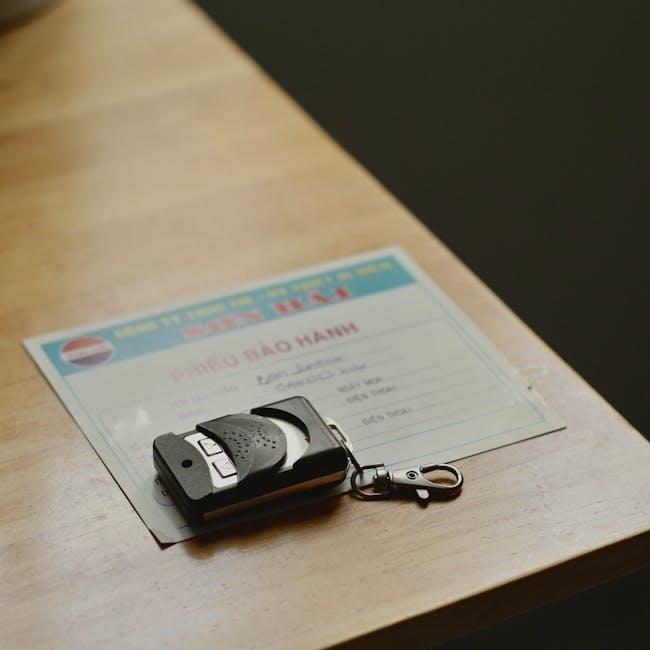Arturia KeyStep Pro Manual: A Comprehensive Guide
Welcome to the world of the Arturia KeyStep Pro! This comprehensive guide serves as your gateway to mastering this powerful sequencing keyboard․ Within these pages, you’ll discover everything from basic functionalities to advanced techniques․ Get ready to unlock the full potential of your KeyStep Pro․
Overview of KeyStep Pro Features and Functionalities
The Arturia KeyStep Pro is a feature-rich standalone keyboard controller designed to be the centerpiece of your music production setup․ It boasts four independent sequencer tracks, offering unparalleled flexibility for creating intricate patterns and melodies․ Each track can control a different synthesizer, drum machine, or even software instrument via MIDI or CV/Gate․
The KeyStep Pro’s intuitive interface provides hands-on control over every aspect of your sequences, allowing for real-time adjustments and creative experimentation․ The velocity-sensitive keyboard offers a responsive playing experience, while the dedicated knobs and buttons provide immediate access to essential parameters․ With its comprehensive connectivity options, including MIDI, USB, CV/Gate, and clock inputs/outputs, the KeyStep Pro seamlessly integrates with both modern and vintage gear․
Furthermore, the KeyStep Pro features a built-in arpeggiator, chord mode, and scale mode, expanding your creative possibilities and simplifying complex musical tasks․ Whether you’re a seasoned producer or just starting out, the KeyStep Pro’s intuitive design and powerful features will empower you to bring your musical ideas to life․ Explore the possibilities and discover the power within․
KeyStep Pro Quick Start Guide
Ready to dive into the world of the KeyStep Pro? This quick start guide will get you up and running in no time․ First, connect the KeyStep Pro to a power source using the included USB cable or an optional power adapter․ Next, connect your MIDI devices or synthesizers to the MIDI output ports on the back panel․ For modular synths, use the CV/Gate outputs․
Power on the KeyStep Pro and select a sequence track using the Track buttons․ Start playing notes on the keyboard to record your sequence in real-time․ Adjust the tempo using the Tempo knob and experiment with different time divisions using the Time Division buttons․ Use the Record, Play, and Stop buttons to control the sequencer․

Explore the Arpeggiator and Chord modes for instant inspiration․ Connect the KeyStep Pro to your computer via USB to use it as a MIDI controller with your favorite DAW․ For advanced features and customization options, refer to the full user manual․ This quick start guide is just the beginning․ Now go forth and create some amazing music with your KeyStep Pro!
Registering Your KeyStep Pro Controller
Congratulations on acquiring your Arturia KeyStep Pro! Registering your controller is a crucial step to unlock its full potential and gain access to exclusive benefits․ To begin, visit the Arturia website and navigate to the registration page․ You’ll need to create an account or log in if you already have one․
Once logged in, enter the serial number of your KeyStep Pro, which can be found on the underside of the unit or on the packaging․ Follow the on-screen instructions to complete the registration process․ By registering your KeyStep Pro, you’ll gain access to software updates, ensuring your controller is always running the latest firmware․
Additionally, registration provides access to Arturia’s support resources, including FAQs, troubleshooting guides, and direct assistance from their technical team․ You’ll also be eligible for special offers and promotions․ Don’t miss out on these valuable benefits – register your KeyStep Pro today and embark on a seamless music creation experience․ This simple process ensures you’re always in the loop with the latest improvements and support․

Understanding the User Manual
The KeyStep Pro user manual is your comprehensive guide to unlocking the full potential of your Arturia sequencer and controller․ This document meticulously details every feature, function, and setting, ensuring you can navigate its capabilities with confidence․ Familiarizing yourself with the manual is the first step toward mastering the KeyStep Pro․
The manual is structured to provide a clear understanding of the KeyStep Pro’s layout, controls, and connectivity options․ It covers topics ranging from basic setup and configuration to advanced sequencing techniques and MIDI implementation․ Each section is carefully explained with diagrams and step-by-step instructions․
Whether you’re a beginner or an experienced musician, the user manual offers valuable insights into maximizing your creative workflow․ It includes troubleshooting tips, FAQs, and detailed explanations of less obvious features․ By studying the manual, you’ll be equipped to tackle any musical challenge and harness the full power of the KeyStep Pro in your productions․ Regularly referring to it will undoubtedly enhance your understanding and workflow․

Using KeyStep Pro with Modular Systems
The KeyStep Pro seamlessly integrates with modular synthesizer systems, offering unparalleled control and sequencing capabilities․ Its four independent sequencer tracks, each with dedicated CV/Gate outputs, allow you to drive multiple modules simultaneously․ This opens up a world of sonic possibilities, enabling complex polyrhythms, intricate melodies, and evolving textures within your modular environment․
Connecting the KeyStep Pro to your modular system is straightforward․ Simply use the CV/Gate outputs to send pitch and gate signals to your oscillators, filters, and other modules․ The assignable CV outputs can be used to modulate parameters such as filter cutoff, resonance, or amplitude, adding dynamic expression to your sounds․ Furthermore, the clock output can synchronize your entire modular system, ensuring tight timing and cohesive rhythmic patterns․
Experiment with different sequencing modes, such as step sequencing, real-time recording, and pattern chaining, to create intricate and evolving modular compositions․ The KeyStep Pro’s intuitive interface and extensive connectivity options make it an ideal centerpiece for any modular setup, providing the control and flexibility needed to explore the vast sonic landscape of modular synthesis․
KeyStep Pro as a MIDI Controller
Beyond its sequencing prowess, the KeyStep Pro excels as a versatile MIDI controller, offering comprehensive control over your virtual instruments, DAWs, and other MIDI-enabled devices․ Its velocity-sensitive keys provide a responsive playing experience, while the assignable knobs and sliders allow for tactile manipulation of software parameters․ Seamlessly integrate the KeyStep Pro into your existing studio setup and unlock a new level of creative expression․
Connecting the KeyStep Pro to your computer via USB provides instant MIDI connectivity․ The KeyStep Pro is class-compliant, meaning no additional drivers are required for most operating systems․ Once connected, you can assign the knobs, sliders, and transport controls to various parameters within your DAW or virtual instruments․ Control volume levels, adjust EQ settings, manipulate synthesizer parameters, and more, all from the intuitive interface of the KeyStep Pro․
The KeyStep Pro also features MIDI input and output ports, allowing you to connect external MIDI devices such as synthesizers, drum machines, and other controllers․ Use the KeyStep Pro as a central hub for your MIDI setup, routing MIDI data between different devices and creating complex MIDI routings․ The possibilities are endless when you harness the full potential of the KeyStep Pro as a MIDI controller․
Clock Receive Settings for Slave Mode
To synchronize the KeyStep Pro with external devices, such as drum machines or other sequencers, you’ll need to configure the clock receive settings for slave mode․ This allows the KeyStep Pro to follow the tempo and timing information sent by the master device, ensuring tight synchronization between all your instruments․ Accessing the “Utility” menu is the first step in configuring the KeyStep Pro as a slave device․
Navigate to the “MIDI Settings” within the Utility menu to access the clock receive options․ The key setting here is “Clock Receive,” which must be set to “On” to enable slave mode․ When enabled, the KeyStep Pro will ignore its internal clock and instead synchronize to the incoming MIDI clock signal․
You can further refine the synchronization by adjusting the “Slave Sync” options․ This allows you to specify how the KeyStep Pro responds to the incoming clock signal․ Experiment with different settings to find the optimal synchronization for your setup․ Proper configuration of the clock receive settings is crucial for seamless integration with external devices and creating cohesive musical arrangements․ By enabling the clock receive, the KeyStep Pro will follow the tempo and start/stop commands of the master device․

Firmware Updates and Manual Versions
Keeping your KeyStep Pro’s firmware up-to-date is crucial for optimal performance and access to the latest features․ Arturia regularly releases firmware updates that address bugs, improve functionality, and introduce new capabilities to the KeyStep Pro․ These updates ensure that your controller remains compatible with the latest software and hardware․ Regularly checking for updates is essential for maintaining a smooth workflow and maximizing the potential of your device․
To update the firmware, download the latest version from the Arturia website․ Follow the instructions provided in the update guide to install the firmware correctly․ It’s important to back up your settings before performing an update, as the process may reset some configurations․
Alongside firmware updates, Arturia also releases updated versions of the KeyStep Pro manual․ These revisions reflect changes in the firmware and provide the most accurate information about the controller’s features and operation․ Always refer to the latest manual version to ensure you have the most up-to-date instructions and guidance․ The manual version is typically indicated on the cover or within the document’s metadata․ Staying informed about both firmware updates and manual versions will help you get the most out of your KeyStep Pro․
Troubleshooting and FAQs
Encountering issues with your KeyStep Pro? This section addresses common problems and frequently asked questions to help you get back on track․ Before contacting Arturia support, consult this troubleshooting guide for quick solutions․ Many issues can be resolved with simple adjustments or by understanding specific functionalities․ We’ll cover topics ranging from connectivity problems to sequencer behavior․
One common issue is MIDI connectivity․ Ensure your KeyStep Pro is properly connected to your computer or other MIDI devices․ Check the MIDI settings in your DAW or software to confirm that the KeyStep Pro is recognized as a MIDI input and output device․ If you’re experiencing problems with the sequencer, review the steps for recording and playing back sequences in the manual․
Another frequently asked question relates to firmware updates․ If you encounter errors during the update process, ensure you’re using the correct firmware version and that your KeyStep Pro is connected directly to your computer via USB․
If you can’t find a solution to your problem here, the Arturia website offers additional resources, including a support section and user forums․

Leave a Reply